|
Marvels of the New West—1887—by
William M. Thayer
278
RAILROADS OVER MOUNTAINS.
 In no way
can we exhibit the marvel of enterprise to such advantage as by
a description of railways through the deepest cañons and
over the highest mountains. The prediction, fifty years ago, that
the time would come when pleasure-seekers would travel in Pullman
cars, where then explorers died of hunger, would have been received
with derisive laughter. Yet this strange experience has been realized. In no way
can we exhibit the marvel of enterprise to such advantage as by
a description of railways through the deepest cañons and
over the highest mountains. The prediction, fifty years ago, that
the time would come when pleasure-seekers would travel in Pullman
cars, where then explorers died of hunger, would have been received
with derisive laughter. Yet this strange experience has been realized.
We have already spoken of the Arkansas Cañon as a physical
wonder; it remains to show how human enterprise has converted
it into a public thoroughfare, marvellous both in its conception
and execution.
It is not known that man or beast ever passed through this
remarkable gorge until the year 1870. When the project of constructing
a railway through it was first made public, it was received with
doubt and ridicule. Engineers said, "The thing is impossible."
After elaborate examination, however, and long, thoughtful research
and study, an engineer, in whose dictionary the word "impossible"
was never put, was found willing and anxious to undertake the
work. Under his skilful management, the railway was built, and
a new and scarcely dreamed of pleasure offered to the public.
It was necessary to begin the work of constructing the railway
several hundred feet above the river, splitting the granite walls
downward. Workmen were suspended from the edge of the cañon
above by ropes, and lowered to the spot where operations must
commence, as seen in the illustration. There they hung, midway
between the opening above and the bed of the river, until a foothold
was secured by drilling and splitting. The obstacles and perils
attending such a remarkable enterprise cannot be overestimated.
The engineer, with faith and courage enough to undertake a work
of such magnitude, must be accorded a high place among the world's
benefactors. But
279
all difficulties were overcome by patience and perseverance,
and the marvellous work was accomplished without an accident.
The ten miles of railway through this cañon cost $1,400,000
(one million four hundred thousand dollars), or one hundred and
forty thousand dollars per mile.
The walls of the cañon two thousand feet high, approach
nearest to each other at the "Royal Gorge," where they
are not more than thirty feet apart. Here the passage is too narrow
for both river and railway, so a bridge is suspended over the
chasm by rods, over which the railway train passes on its way.
The scene is totally unlike anything the traveller has witnessed
before. It is awe-inspiring and even fearful. There were from
sixty to seventy passengers on the train when the author passed
through the cañon in an observation-car. Not a word was
spoken. No merriment was noticeable. Silent, serious thoughtfulness
marked every countenance. Several passengers unconsciously rose
to their feet and uncovered their heads, as if in the immediate
presence of the Author of all this grandeur. A woman directly
in front of the writer bowed her head and wept. A score of others
showed their honest sympathy with her by their irrepressible emotion,
as unbidden tears bedimmed their vision.
The scene and the occasion of the first railway excursion through
this cañon was graphically described by the Denver Tribune
as follows:—
"The most stupendous achievement of railway engineering over
Nature's efforts to obstruct the pathway of commerce, was triumphantly
achieved on the 7th of May, 1879, by the Atchison, Topeka and
Santa Fe Railway Company, which on that day made the passage of
the Grand Cañon of the Arkansas, with a train of cars carrying
an excursion party of ladies and gentlemen, numbering over two
hundred persons. This rock-bound river pathway became known to
Spanish missionaries as early as the year 1642. From that time
it was not known that any animal life had ever passed through
it successfully until the winter of 1870. The approach to the
Cañon is gradual. The distant hills draw nearer, and the
valley of the Arkansas becomes narrower and narrower, until the
river is shut in closely on both sides by high mountains, sloping
gently away and covered with verdure. Then the slope. of the mountains
becomes more perpendicular, and the hills become higher, until
suddenly the river is completely shut in by mountains with mighty
tops. The roar and rattle of the train grows louder and echoes
up and down. The train
280
is fairly in the cañon. It moves slowly. The mountain
walls are of a dizzy height, and so close together that, looking
ahead, they appear simply to form a crevice, a huge, awful, crooked
crevice, through which the miserable little train is timidly crawling.
The curves of the cañon are superb. They constitute the
finishing touch to its grandeur, and fill the mind with a full
appreciation of this great miracle of nature. But the Royal Gorge!
Imagine two almost perfectly perpendicular walls rising to the
height of two thousand feet, those walls presenting jagged and
irregular masses of rock that on the railroad side hang over the
train all creviced and ready to fall in thousands of tons. The
road-bed is cut out of the solid rock, and masses of this bang
over it, stretching out a hundred feet. One cannot look up to
the top of this wall on account of those projecting, irregular
bluffs, but the height to the top, even as measured by the eye,
disturbs the faculties and brings on vertigo. The cooped-up Arkansas
rushes madly by, a narrow thread, made still more so by the rocks
thrown into it. There is not room to step from the train without
pitching into the river. Not a word is uttered. The engineer whistles
occasionally, and timid folks look for the rocks to fall. It is
really a strain on the mind to take it in; and this can be only
feebly done on a single trip. Two thousand feet above you are
the tops of the mountain walls. You are imprisoned in a crack
thirty feet wide, and are partially under one mountain wall. You
can see on the opposite side the gradations of the verdure, rich
below, impoverished above. And the curves become more awful as
you look ahead or back.
"There was no sun in the Gorge, but it slanted down the
opposite mountain wall as the party returned through the cañon,
increasing the surpassing beauty of the scene."
Leaving the Arkansas Cañon, and traversing the upper
Arkansas Valley, as lovely as it is narrow, the train begins to
scale the heights of Marshall Pass. The serrated peaks of the
Sangre de Cristo are in full view at the west, and the scene is
indescribably grand. Two ponderous engines puff and tug upward
with their train of human freight. Looking far away towards the
summit, a narrow rim or line is seen. "That is the track
over which we are to pass to the summit," said the conductor.
Winding around the mountains, through the deep, wild ravines,
ascending from one hundred and fifty to two hundred and ten feet
to the mile, in one hour the train triumphantly gains the summit,
ten thousand seven hundred and sixty feet above the sea. Such
a panorama here opens to the view! The Sangre de
281
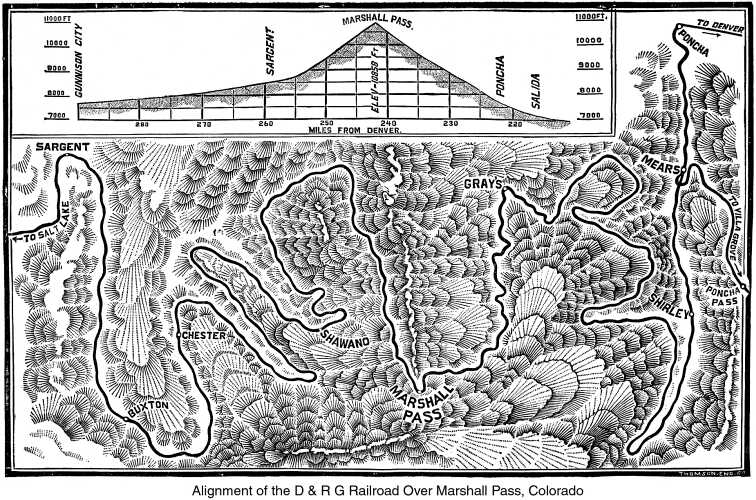
THE above cut shows the marvellous railroading
over Marshall Pass. The Pass is entered almost imperceptibly from
Poncha Pass, and the whole wonderful ascent might very readily
be imagined as one and the same. The summit is almost eleven thousand
feet above the sea, and the tortuous method by which the daring
engineers of the Denver and Rio Grande Railroad have achieved
this summit can best he understood by studying this cut, which
illustrates the alignment of the track.
282
Cristo Range looms up in the distance, wearing a crown of snow
that glistens in the distance, while the great San Luis Park,
larger than the State of Connecticut, stretches out at its base.
Westward the mountain peaks are less towering, but the scene is
no less inspiring.

283
Looking down into the Tomichi Valley, two thousand feet, perhaps,
the railway track is seen doubling back and forth in its zigzag
course to Gunnison City. The vision is unobstructed, and the traveller
begins to comprehend what a joy it is to stand upon the "Continental
Divide," and "survey creation round." How is it
possible for the railroad train to reach the valley below in safety,
turning sharp curves, rounding abrupt headlands, and gliding along
the verge of awful precipices? But it does; and when the delighted
passenger looks backward and upward from the valley to the cold,
bleak, bewildering height from which he has descended, he wonders
still more how it was done.
This route is embraced in what the managers of the Rio Grande
Railway denominate "The Scenic Route"; and truly it
is all of that. Any railway crossing the Rocky Mountains or the
Sierra Nevadas must necessarily take a route that is "scenic."
Grand and beautiful scenery exists in profusion everywhere. Rising
from extended "plains" into mountainous regions, through
cañons whose mighty walls on either side tower two thousand
feet towards the sky, with here and there a pinnacle hundreds
of feet higher, peaks of different shape and size piled one above
another, cliff on cliff ascending to dizzy heights, rushing torrents
far, far below the track, and silvery cascades leaping from dizzy
summits, with here and there a park or lake stretching out for
miles its fruitful acres or silver sheen, eight thousand feet
above the sea,—such a route possesses enough of the grand,
beautiful, and sublime to challenge the appellation, "scenic."
A description of a trip through Platte Cañon will still
further exhibit the marvels of railroad enterprise in the New
West.
Twenty miles from Denver the train entered the cañon
upon a shelf so narrow as to suggest the thought that railroad
builders were willing to accept the smallest favor from the contesting
Platte torrent. Once within the cañon, the train began
to ascend the steep grade, winding its serpentine way under the
shadow of overhanging rocks and frowning cliffs, round and round,
higher and higher, up, up, up, often rising two hundred feet to
the mile, with castellated walls towering a thousand feet above,
and here and there a mountain-peak shooting two or three thousand
feet into the air, presenting a scene of grandeur and sublimity
that baffles description. We were filled with surprise and wonder.
Every curve disclosed new glories; every mile bore witness to
the indomitable perseverance and tact of man.
The "tug of war" to the locomotives was on the home
stretch
284
 between Webster
and Kenosha Divide, which is 10,139 feet above the sea. The ascent
is steep and perilous, and the railway track doubles back and
forth upon itself several times in order to scale the heights.
It is two miles to the summit; but that point cannot be reached
without winding about, going eight or ten miles to ascend two.
At a point near Webster, the conductor requested the passengers
to look down into the valley from whence they had come. The descent
to the valley was almost perpendicular, and the distance from
fifteen hundred to two thousand feet. Obeying the request, we
looked down, and lo! there nestled in the valley the neat little
village we had left some time before directly under us, the houses
appearing no larger than hen-coops, and a horse and cart on the
street resembling a child's toy horse and cart. A sense of danger
came over us as we gazed for a moment and then turned away from
a marvel that one does not care to view too long. between Webster
and Kenosha Divide, which is 10,139 feet above the sea. The ascent
is steep and perilous, and the railway track doubles back and
forth upon itself several times in order to scale the heights.
It is two miles to the summit; but that point cannot be reached
without winding about, going eight or ten miles to ascend two.
At a point near Webster, the conductor requested the passengers
to look down into the valley from whence they had come. The descent
to the valley was almost perpendicular, and the distance from
fifteen hundred to two thousand feet. Obeying the request, we
looked down, and lo! there nestled in the valley the neat little
village we had left some time before directly under us, the houses
appearing no larger than hen-coops, and a horse and cart on the
street resembling a child's toy horse and cart. A sense of danger
came over us as we gazed for a moment and then turned away from
a marvel that one does not care to view too long.
From Kenosha Divide the train descended into South Park, introducing
the sight-seer to a spectacle for which he is wholly unprepared,—a
park level as a house floor, containing two thousand two hundred
square miles, nine thousand five hundred feet above the level
of the sea, and completely walled with mountain peaks, covered
with perpetual snow. The illustration furnishes the curve of the
railway at the head of the park, with a view of the enormous plain
and the tall snowy range.
Before the time of railroads, a line of stages passed along
the northerly rim of the park, over Mosquito Pass, which is twelve
thousand feet above the sea. This was the highest stage line in
the world.
285
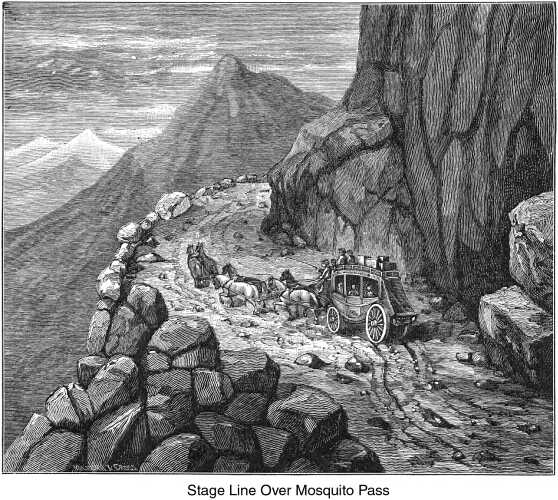 Some of the
heaviest railroad work and most remarkable scenery of the New
West are found between South Park and Leadville by the way of
Breckinridge. An observer describes the scenic features of the
route so vividly, that we quote him in full. "From Como,
with the first revolution of the wheels, the climb for the crest
between two oceans begins. Ahead are the hills, snow-crowned;
behind, the Park where a hundred shades blend in a picture vast
and rare. In the first gulch traversed, miners are washing gold.
Towns and ranches dot the receding levels. Unexpected tints develop
with every foot of progress. The feelings of the moment admit
of no record. As timber line is approached there is something
awful in the grandeur. The mountains tower lifeless and sombre.
Even the trees are dead and standing gaunt and fire scarred. Far
below a stream crooks itself along the valley. At Boreas, 11,496
feet above the sea, the summit is reached. From this point the
view is sublime and full of warmth. The trees are dense and luxuriant.
Their piney odor fills the summer air. Ten Mile range rises in
the near distance, Some of the
heaviest railroad work and most remarkable scenery of the New
West are found between South Park and Leadville by the way of
Breckinridge. An observer describes the scenic features of the
route so vividly, that we quote him in full. "From Como,
with the first revolution of the wheels, the climb for the crest
between two oceans begins. Ahead are the hills, snow-crowned;
behind, the Park where a hundred shades blend in a picture vast
and rare. In the first gulch traversed, miners are washing gold.
Towns and ranches dot the receding levels. Unexpected tints develop
with every foot of progress. The feelings of the moment admit
of no record. As timber line is approached there is something
awful in the grandeur. The mountains tower lifeless and sombre.
Even the trees are dead and standing gaunt and fire scarred. Far
below a stream crooks itself along the valley. At Boreas, 11,496
feet above the sea, the summit is reached. From this point the
view is sublime and full of warmth. The trees are dense and luxuriant.
Their piney odor fills the summer air. Ten Mile range rises in
the near distance,
286
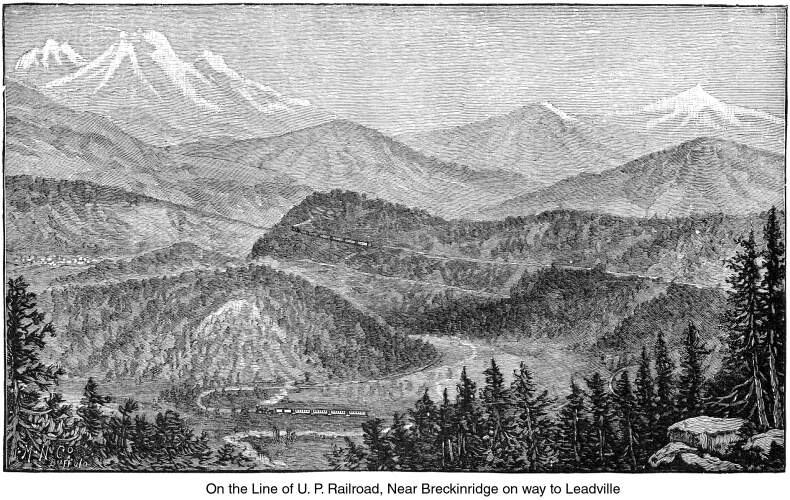
ponderous and pure under its snow. You are looking down the
valley of the Blue, by many considered the loveliest encompassed
by the Rockies. Over it is a blue-gray mist like a veil, that
parts at the touch of the sun. Mines in every direction place
romance and reality
287
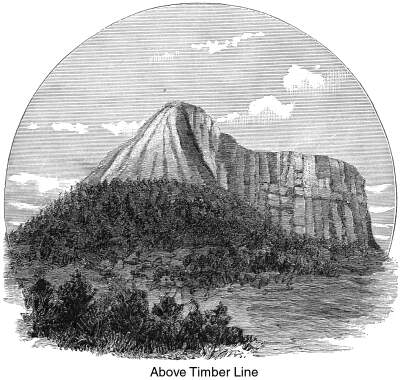 hand in hand.
The Atlantic Slope fades from sight. An old Ute trail can just
be discerned on the banks of the stream, lost now and again in
the trees. Pacific Peak frowns down snowily, heedless that summer
winds are playing about its base. It is full of silver and gold,
and men are delving for it." hand in hand.
The Atlantic Slope fades from sight. An old Ute trail can just
be discerned on the banks of the stream, lost now and again in
the trees. Pacific Peak frowns down snowily, heedless that summer
winds are playing about its base. It is full of silver and gold,
and men are delving for it."
The illustration affords the reader a fine view of the railway
in its upward course to the mountain summit, winding about among
the peaks, which are marvellous in size and numbers, until the
laboring locomotive halts like a conqueror upon the crest.
The writer quoted speaks of "timber line." "Timber
line" is the altitude above which vegetation ceases. The
altitude varies from 10,500 to 11,500 feet, and is too bleak and
cold for tree or shrub to live. Barrenness and desolation, or
perpetual snow, meet the eye above the altitude named. Our illustration
shows very clearly what "timber line" is.
The "Alpine Tunnel" is reached through "Chalk
Creek Cañon,"—a ride of wonderful interest. Some
tourists have declared that this ride cannot be duplicated in
the whole world; that neither writer nor painter can do justice
to the attractions. From personal observation we affirm that some
of the wildest scenery which we saw in the Rocky Mountains was
seen here. In some localities it ceased to
288
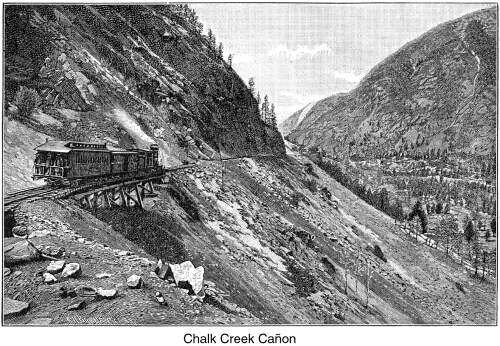 be grand and
became awful. The thought of penetrating such an "abyss of
desolation" in a Pullman car would have seemed absurd but
for the fact that ours was doing that very thing. A photographic
view in this cañon, at an interesting point, will give
a good idea of the wild, rough, and desolate appearance of the
gorge. be grand and
became awful. The thought of penetrating such an "abyss of
desolation" in a Pullman car would have seemed absurd but
for the fact that ours was doing that very thing. A photographic
view in this cañon, at an interesting point, will give
a good idea of the wild, rough, and desolate appearance of the
gorge.
We remember with peculiar interest a descent into a narrow
valley, where, in order to ascend the mountains on the opposite
side, the railway made a detour of several miles, skirting a lot
of five or six acres or more in performing the feat. We drew a
plan of the road in our note-book at the time; and subsequently
found a pictorial representation of it (see following page).
At a point eight or ten miles from the Alpine Tunnel, a passenger
said, pointing to the west, "See that black spot yonder!
that is the tunnel." The "black spot" appeared
to be about as large as a man's bat, and a mile away. All were
surprised to be told that it was distant eight or ten miles.
"The tunnel is above timber-line,'' continued our informant,
"too high up for anything to grow."
"What is the altitude?" we asked.
"Eleven thousand six hundred and twenty-three feet above
the sea, the highest railway in the world, except one in the South
American Andes."
289

290
The tunnel is one thousand seven hundred and seventy-three
feet long, with approaches which add eight hundred feet more,
and is six hundred feet beneath the Pass. It conducts the passenger
from the Atlantic to the Pacific Slope in a few minutes.
Nearly two years were occupied in building this tunnel. Its
twenty thousand lineal feet of California red-wood lining was
brought up on pack-horses over trails which had known the touch
of no hoof but the mountain sheep's, and where man himself had
scarce dared to venture. Operations were carried on from both
ends, and, despite the curvature, when the respective gangs first
caught the flash of each other's lamps, they wore less than one
inch out of the way as the engineer had mapped it for them. The
great expense was only warranted by the greatness of the country,
which is now fastened to the outer world by this link of stygian
darkness."
The point in the tunnel where the train passes from the Atlantic
to the Pacific Slope is at the centre; and the writer whom we
have just quoted says: "The impetus tells the moment it is
crossed, and the engines, before goaded to their work, have to
be held in severe curb by the courageous drivers. Two drops of
water, such as continually fall from the roof, alight but half
an inch apart. Trembling a second in the balance, each starts
with its fellows; and when they join finally the ocean, there
is the span of a continent between them."
The reader may be interested, at this point, in the following
about European tunnels. -At the present time the Alpines are pierced
by three remarkably long tunnels, entering Italy from France,
Switzerland, and Austrian Tyrol, respectively, and called according
to the mountain chains that are traversed, the Mt. Cenis, St.
Gothard, and Arlberg tunnels. Of these Mt. Cenis is seven miles
and three-quarters in length. Its cost was $15,000,000 The St.
Gothard tunnel is nine miles and a quarter in length, and cost
$13,500,000, the diminution in expense being due principally to
the more rapid progress of the work by improvements in the drilling-machines.
The Arlberg tunnel is shorter than either Mt. Cenis and St. Gothard,
being only six miles and a half. The last and most formidable
rival will be the Simplon tunnel, by which the existing line from
Geneva to Martigni and Brieg will be carried through the mountains
to Dumo d'Ossola, and so on to Pallanza or Stresa on the Lago
Maggiore. As this tunnel will be commenced at a much lower level
than any of the others, it will necessarily be large, the rough
estimate being twelve miles and a half and the estimated cost
somewhere about $20,000,000."
291
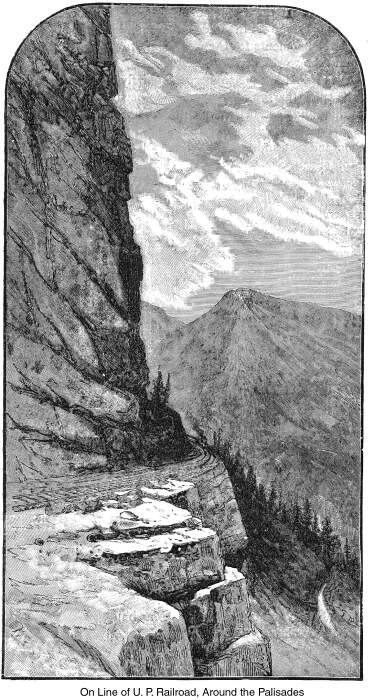
292
Emerging from the tunnel upon the Pacific slope, the scene
is indescribable. The train creeps cautiously around the Palisades,
pausing a few moments for the passengers to take in a view which
a trip around the world cannot furnish.
Here the Palisades rise perpendicularly several hundred feet
above the track (narrow-gauge), which is hewn out of its side.
More than a thousand feet below, the railway, over which the train
will pass, is visible, resembling a narrow shelf in the side of
the mountain. Two thousand feet and more below is Quartz Creek,
running like a thread of silver through the valley. Poised upon
this shelf, with unsurpassed grandeur above, around, and beneath,
the Christian observer is filled with "wonder, love, and
praise." The height is perilous, and the traveller finds
himself clutching tightly the platform-rail as he looks down into
the deep abyss at his feet; yet devoid of fear. The scene is so
novel, so overpowering, and bewitching in its effects, that there
is no place for fear. An observer said, what other observers can
appreciate, "One forgets that an overturned coach would hurl
him thousands of feet down into the abyss, and feels that if such
a catastrophe were to happen while his eyes feasted on that glorious
landscape, he would die happy."
"How many feet do you think it is down into the valley?"
we inquired of a fellow-traveller, in whose face could be seen
traces of alarm.
"I have no idea," be answered solemnly, adding, after
a moment's hesitation, "we are not far from eternity,"—a
remark that is true of us mortals at almost any time and anywhere;
perhaps a little more significant and impressive up there clinging
to the Palisades, nearly twelve thousand feet above the sea. Nevertheless,
all things considered, it is true, doubtless, that a man is no
nearer eternity when he emerges from the "Alpine Tunnel"
than he is on the "Great Plains." There have been no
accidents there; every precaution against accident has been provided
without regard to expense, not the least of which is the instant
stopping of the cars by automatic pressure in case of disaster.
We do not deny that there is more danger in travelling by rail
over mountains than there is over plains; but the additional novelty
and pleasure offsets the peril. While I am writing, the news comes
that the air-break of a freight train near Marshall Pass became
useless, when the train dashed forward with constantly accelerating
speed, until, going at the rate of fifty or sixty miles an hour,
the locomotive leaped from the track down into the gorge hundreds
of feet below,
293
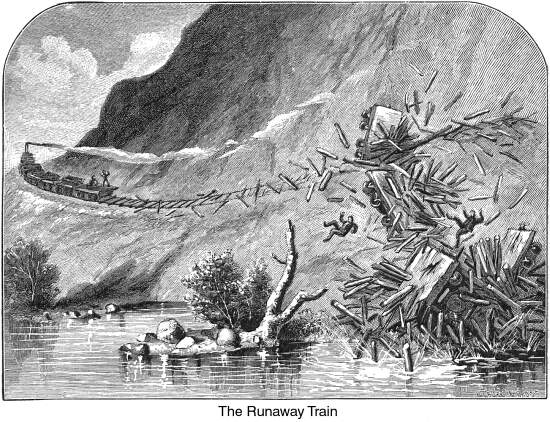 carrying the
twenty loaded cars with it,—a complete wreck of everything. carrying the
twenty loaded cars with it,—a complete wreck of everything.
Mr. Crofutt relates a thrilling incident in Echo Cañon,
illustrative of the foregoing:—
"Mr. Miles, or 'Paddy,' as he was familiarly called, was
foreman to the Casement brothers, who laid the track of the Union
Pacific Railroad. One morning, Paddy started down Echo Cañon
with a long train of flat cars, sixteen in number, loaded with
ties and iron rails for the road below Echo City, where were then,
as now, the stations, switches, etc. The reader will remember
that from the Divide to the mouth of Echo Cañon is a heavy
grade, no level place on which cars would slack their speed.
"The train had proceeded but a few miles down the cañon,
going at a lively rate, when the engineer discovered that the
train had parted, and four loaded cars had been left behind. Where
the train parted, the grade was easy, hence that portion attached
to the locomotive bad gained about half a mile on the stray cars.
But when discovered they were on heavy grade and coming down on
the train with lightning speed. What was to be done? The leading
train could not stop to pick them up, for at the rate of speed
at which they were
294
approaching, a collision would shiver both trains, destroying
them and the lives of those on board.
"There were two men—Dutchmen—on the loose cars,
who might put on the brakes and stop the runaway. The whistle
was sounded, but they heard it not; they were fast asleep behind
the pile of ties. On came the cars, fairly bounding from the track
in their unguided speed, and away shot the locomotive and train.
Away they flew, on, around curves and over bridges, past rocky
points and bold headlands; on with the speed of the wind, but
no faster than came the cars behind him.
"'Let on the steam!' cried Paddy; and with the throttle
chock open, with wild, terrible screams of the whistle, the locomotive
plunged through the gorge, the mighty rocks sending back the screams
in a thousand ringing echoes.
"'Off with the ties!' shouted Paddy once more, as the
whistle shouted its warning to the station men ahead to keep the
track straight and free, for there was no time to pause—that
terrible train was close on to them, and if they collided, the
cañon would have a fearful item added to its history. On
went the train past the sidetracks, the almost frantic men throwing
off the ties, in hopes that some of them would remain on the track,
throw off the runaways, and thus save the forward train. Down
the gorge they plunged, the terror keeping close by them, leaping
along,—almost flying, said one, who told us the tale, -while
the locomotive strained every iron nerve to gain on its dreaded
follower. Again the wild scream of the locomotive, of 'switches
open,' rung out on the air, and was heard and understood in Echo
City. The trouble was surmised, not known, but the switches were
ready; and if the leading train had but the distance, it could
pass on, and the following cars be switched off the track and
allowed to spend their force against the mountain side. On shot
the locomotive, like an arrow from the bow, the men throwing over
the ties until the train was well-nigh unloaded, when just as
they were close to the curve by which the train arrives at the
station, they saw the dreaded train strike a tie, or something
equally of service, and with a desperate plunge rush down the
embankment into the little valley and creek below. 'Down brakes,'
screamed the engine, and in a moment more the cars entered Echo
City, and were quietly waiting on the side-track for further developments.
The excited crowd, alarmed by the repeated whistling, was soon
informed of the cause of these screams, and immediately went up
the track to the scene of the disaster to bring in the dead bodies.
When they arrived,
295
 they found
the poor unfortunates sitting on the bank unharmed, having just
woke up. The first they knew of the trouble was when they were
pitched away from the broken cars on the soft greensward. The
debris of car frames, wheels, and ties, gave them the first
intimation they bad received that something was the matter." they found
the poor unfortunates sitting on the bank unharmed, having just
woke up. The first they knew of the trouble was when they were
pitched away from the broken cars on the soft greensward. The
debris of car frames, wheels, and ties, gave them the first
intimation they bad received that something was the matter."
Yes, there is danger, but there is also delight; and the fascination
of the latter more than counterbalances the reality of the former.
The descent from the Palisades is made by the "Hair-Pin
Curve," so named from the resemblance which the curve in
the road bears to a hairpin.
The array of mountains, and the splendors of the scene on every
hand, do not diminish on leaving the Palisades. Grand beyond comparison
rises the Uncompahgre, 14,235 feet above the sea, a monarch among
the mountain peaks, leaning in royal dignity against the horizon,
and looking down from his pinnacle of fame upon the lesser peaks
around him.
296
 Ere this the
reader has inquired within himself, why railroads in the Rocky
Mountains are not blockaded with snow through the winter. At the
East, where the snow-fall is far less than it is among the mountains
of the West, railroads are frequently blocked with snow for several
days. And yet, it is claimed that, on the whole, trains on the
mountain-roads are not so frequently delayed by snow as trains
are in the East. It was not so, however, in the infancy of these
railways, as the long and expensive blockade of February and March,
1869, on the Union Pacific, proves. When the railroad across the
continent was built, it was known that snow-sheds or galleries,
would be necessary over the Sierra Nevada Mountains, where the
snow is often from sixteen to twenty feet deep. But such a safeguard
against heavy snows was not thought to be necessary in the Rockies,
until experience exposed the mistake. Then snow-fences were resorted
to for protection, as in the East, but in many localities they
proved useless. Hence, snow-sheds are the chief reliance now.
The above cut gives a fine view of a curve in the Central Pacific
Railway, on the Sierra Nevada Mountains, with the snow-sheds. Ere this the
reader has inquired within himself, why railroads in the Rocky
Mountains are not blockaded with snow through the winter. At the
East, where the snow-fall is far less than it is among the mountains
of the West, railroads are frequently blocked with snow for several
days. And yet, it is claimed that, on the whole, trains on the
mountain-roads are not so frequently delayed by snow as trains
are in the East. It was not so, however, in the infancy of these
railways, as the long and expensive blockade of February and March,
1869, on the Union Pacific, proves. When the railroad across the
continent was built, it was known that snow-sheds or galleries,
would be necessary over the Sierra Nevada Mountains, where the
snow is often from sixteen to twenty feet deep. But such a safeguard
against heavy snows was not thought to be necessary in the Rockies,
until experience exposed the mistake. Then snow-fences were resorted
to for protection, as in the East, but in many localities they
proved useless. Hence, snow-sheds are the chief reliance now.
The above cut gives a fine view of a curve in the Central Pacific
Railway, on the Sierra Nevada Mountains, with the snow-sheds.
On one section of this railway there are twenty-eight miles
of continuous snow-sheds, including several tunnels from one to
sixteen hundred feet in length. If all the snow-sheds. built by
the Union .and Central Pacific were placed in line, they would
extend nearly a 'hundred miles, erected at a cost of one million
dollars. They are built in the most substantial manner, stone
and the heaviest timber being used. The following cut shows the
interior of a snow-shed.
"Snow-slides" are more perilous than snow-storms.
Hence
297
sheds on the mountain sides are built so as to conduct the
avalanche over the roof into the valley below - so that while
the passenger train glides safely through the artificial gallery,
a mighty avalanche of snow may be tumbling over it, and bury,
forty feet deep, the hamlet or village in the valley. If a snow-shed
be necessary on a comparatively level section, it is built with
a sharp roof, like any other building designed to support a heavy
weight of snow.
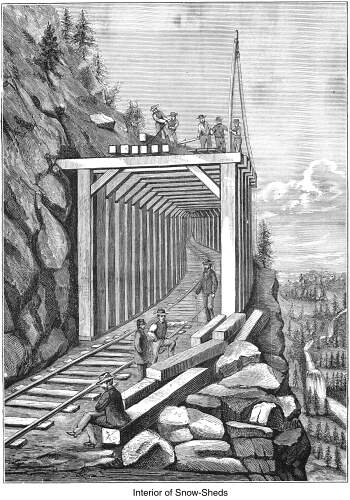
298
A good idea of the magnitude of a snow-slide may be derived
from the fact that, in the winter of 1883-84, a slide completely
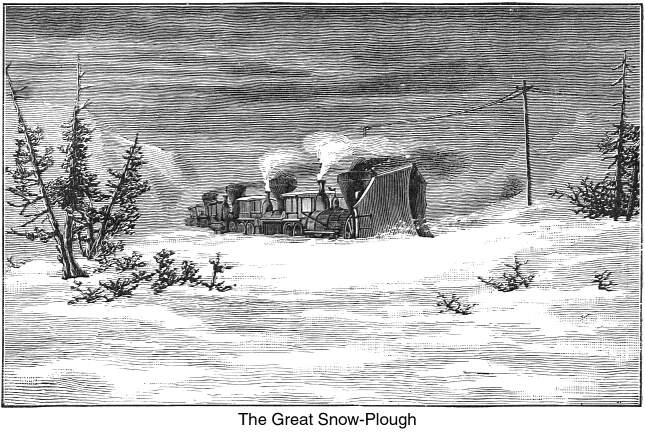 buried a mining
town in one of the cañons of the Rocky Mountains already
described, destroying most of the buildings. It is claimed that
a snow-slide in the Animas Cañon, two years ago, was a
half-mile in length, and when it landed in the deep gorge below,
the snow was forty feet deep. A still more disastrous slide, at
the Virginius mine, near Ouray, was reported by a Colorado paper
as follows:— buried a mining
town in one of the cañons of the Rocky Mountains already
described, destroying most of the buildings. It is claimed that
a snow-slide in the Animas Cañon, two years ago, was a
half-mile in length, and when it landed in the deep gorge below,
the snow was forty feet deep. A still more disastrous slide, at
the Virginius mine, near Ouray, was reported by a Colorado paper
as follows:—
"When the avalanche descended upon the boarding-house at
four o'clock, Saturday, there were eleven men in it, some asleep
in their bunks and others waiting to go -on a night shift; while
Armstrong and Shieldler were in the kitchen. Boyle escaped through
an opening and ran for assistance, and all the men at the mines
were speedily engaged in tunnelling the snow to save the buried
men.
"The party from Ouray, which started out Saturday, reached
the post-office that night, having bad to abandon their horses
and use snow-shoes. Reaching the Monongahela mine, they found
the Virginius workmen there with four corpses. Sleds were made
for the dead bodies, and the parties started yesterday to return
to Ouray, David Reed in front breaking the trail just as they
reached Cumberland basin, another snow-slide came down on David
Reed, and in a second had carried him into the air and over a
precipice before the
299
eyes of the horror-stricken men. Following in another instant,
a second snow-slide descended upon the whole party, carrying away
the thirteen men.
"The sleds they were dragging and the corpses of the men
went nearly two thousand feet down the mountain with the slide,
four of them being hurled over a precipice five hundred feet high.
Superintendent Reed was carried to the edge of a precipice, where
a tree caught and held him. The first man to escape from the slide
was Doyle, who arose bruised and dazed, and looking around, spied
hands and feet protruding from the snow all round. He went to
work to help the buried, each man as fast as rescued assisting
to save the others till all were rescued. The bodies of the four
men killed at Virginius lie under twenty feet of snow, and probably
will remain there until spring."
The Central Pacific Railway has a mammoth snow-plough which
rests upon two four-wheeled trucks. It is twenty-eight feet long,
ten and a half feet wide, thirteen and a quarter high, and weighs
FORTY-ONE THOUSAND EIGHT HUNDRED AND SIXTY POUNDS! It was once
driven by ten locomotives into a snow-bank on the Sierra Nevada
Mountains at the rate of sixty miles an hour.
In this connection the following statement by the London Times
will be read with interest:—
"A statistical memoir lately issued by the Italian government
enables us to form some idea of the great destruction caused annually
by avalanches in the Alpine districts of Italy and the Tyrol.
In the single district of Val di Susa two avalanches fell on Jan.
18; one, at Devies, between Exilles and Salbertand, was estimated
at about sixty metres long and six deep, and slid down the slope
a distance of about a kilometre. Its volume is supposed to have
been three hundred and sixty thousand cubic metres, and the weight
of snow composing it was forty-five thousand tons. It destroyed
sixteen houses and killed forty-three persons. The second avalanche
of Jan. 18 fell near Venaus, was one hundred and fifty metres
long, its volume was about three million cubic metres, and it
bore nearly a quarter of a million tons of snow: But although
the slide extended to nearly four kilometres, only twenty-four
houses were wrecked by it and six persons killed. A third avalanche,
which fell at Maflotto, and was computed to contain little more
than one thousand six hundred tons' weight of snow, was much more
destructive, killing seventeen persons and destroying eighteen
homes,"
300
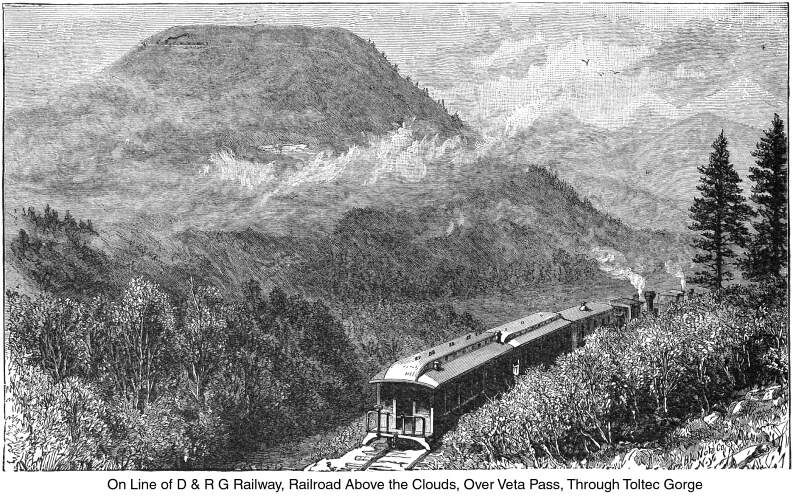
At eight different points the Denver & Rio Grande Railway
has crossed the Rocky Mountains, instead of piercing them with
long and dismal tunnels. The altitude attained in the passage
of Veta
301
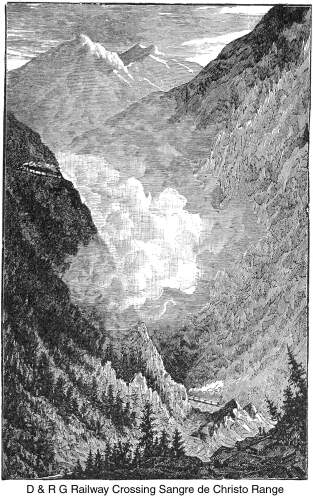 Pass is not
so great as that of Alpine or Marshall passes, but the scenery
is not less remarkable. The ascent begins along the base of La
Veta Mountain, up a defile, at the head of which stands Dump Mountain,
defiant and frowning. The railway approaches the mountain by indirection,"
and doubles so sharply upon itself that the curve has become famous
as the "Mule Shoe Curve." Pass is not
so great as that of Alpine or Marshall passes, but the scenery
is not less remarkable. The ascent begins along the base of La
Veta Mountain, up a defile, at the head of which stands Dump Mountain,
defiant and frowning. The railway approaches the mountain by indirection,"
and doubles so sharply upon itself that the curve has become famous
as the "Mule Shoe Curve."
From this point the ascent is very difficult, the grade being
two hundred and seventeen feet to the mile. The road-bed is little
more than a groove cut in the sides of the mountain, winding hither
and thither over the Sangre de Christo Range, which it crosses
at Veta Pass at an altitude of nine thousand three hundred and
thirty-nine feet. A bowlder started from this point goes thundering
down the precipitous walls into the deep, terrible gorge below,
a mile away.
A tourist christened the railway at this interesting point
"RAILROAD ABOVE THE CLOUDS,'' because, as a matter of fact,
tempests rage, and the artillery of heaven thunders and lightens
below the track.
Passengers enjoy a sublime view from the train at Veta Pass.
Looking eastward, the sky shuts down upon the distant plains,
while, at the west, the majestic form of Sierra Blanca, the highest
mountain
302
peak in this country, rises grandly fourteen thousand four
hundred and sixty-four feet. To the south, the symmetrical "Spanish
Peaks" stand forth so lovely and yet grand in their appearance
as to seem phantom-like.
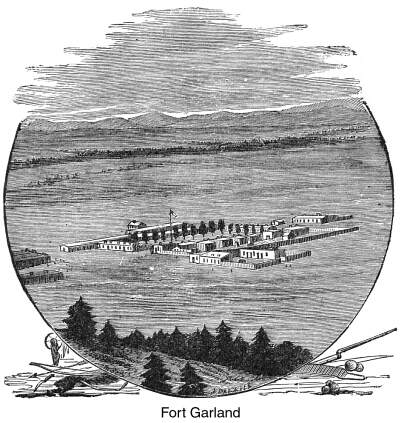 The peaks are
respectively twelve thousand seven hundred and twenty and thirteen
thousand six hundred and twenty feet high, and are known also
as "The Twin Sisters," their Indian name being Wahatoga,
which means "breast." These two mountains stand out
so boldly as to seem almost separated from the range to which
they belong. In a clear day they have been, seen from Denver,
two hundred miles. The peaks are
respectively twelve thousand seven hundred and twenty and thirteen
thousand six hundred and twenty feet high, and are known also
as "The Twin Sisters," their Indian name being Wahatoga,
which means "breast." These two mountains stand out
so boldly as to seem almost separated from the range to which
they belong. In a clear day they have been, seen from Denver,
two hundred miles.
From Veta Pass the train descends, by a zig-zag course, into
San Luis Park—a level tract of land measuring eight thousand
square miles, and containing over five million acres, larger than
the whole State of Massachusetts. The change from mountain to
prairie scenery contributes largely to the novelty and pleasure
of the trip. The entrance to San Luis Park is a beautiful picture
in itself. Fort Garland is located there for the defence of settlers
against the Indians. The buildings are all adobe, that is, built
of sun-burnt brick, making a neat, attractive little village.
The fort will soon be abandoned, no doubt, as the danger from
Indian depredations has ceased to exist.
It is twenty miles and more from Antonito to the summit of
the beautiful mesa which the railway traverses. "The ride
up this mesa, for over twenty miles, is one of the most delightful
imaginable. The railway mounts the heights by an easy grade, winding
in labyrinthine curves among grassy knolls and parks of dark green
303
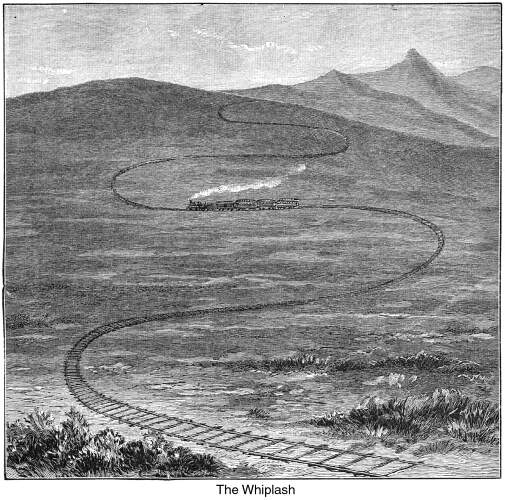 pines, and
piñons, allowing the passengers to measure the elevation
by the plains below, and affording a hundred different views of
Sierra Blanca, the Sangre de Christo range, and the smooth outlines
of the Antonio Mountains." At one place, the railway doubles
upon itself twice, making three parallel tracks in the distance
of a few rods, and, from its shape, as represented in the cut,
is called "The Whiplash." pines, and
piñons, allowing the passengers to measure the elevation
by the plains below, and affording a hundred different views of
Sierra Blanca, the Sangre de Christo range, and the smooth outlines
of the Antonio Mountains." At one place, the railway doubles
upon itself twice, making three parallel tracks in the distance
of a few rods, and, from its shape, as represented in the cut,
is called "The Whiplash."
A waggish traveller, dilating upon the great pleasure to be
derived from a ride over this mesa in a Pullman car, says that
it is the best illustration he has found of being "carried
to the skies on flowery beds of case."
In this part of Colorado the "Garden of the Gods"
is repeated in numerous monumental rocks which appear among the
pines, rising in fantastic columns, some of them nearly as high
as the trees. The artist has produced an excellent representation
of one of the tallest.
One of the most remarkable curves of this railway occurs in
one of the wildest localities known. In the valley beneath the
road are
304
 numerous tall
pine and hemlock trees, with many monumental rocks rising high
and dismal among them, as if a cemetery for departed gods had
been laid out there, and the silence of the dead had been unbroken
until the daring enterprise of civilization penetrated the strange
solitude. It is known as "Phantom Curve." With the monument-shaped
rocks on one side, and the castellated cliffs, five or six hundred
feet high, on the other, the scene is strangely wild and mysterious. numerous tall
pine and hemlock trees, with many monumental rocks rising high
and dismal among them, as if a cemetery for departed gods had
been laid out there, and the silence of the dead had been unbroken
until the daring enterprise of civilization penetrated the strange
solitude. It is known as "Phantom Curve." With the monument-shaped
rocks on one side, and the castellated cliffs, five or six hundred
feet high, on the other, the scene is strangely wild and mysterious.
305
At one point on "Phantom Curve" the first view of
Toltec Tunnel is obtained—so far away that it appears only
as a small black spot on the face of the cliffs.
 The reader
can but partially imagine the grandeur of the scenery viewed from
the train at the opening of the tunnel, which is cut six hundred
feet through solid rock. A writer says of it: "Here the beauty
and the grandeur of the scenery are beyond description. All the
features of the landscape are on a Titanic scale. The track over
which the train has just passed can be seen circling the brow
of the mountain for miles,—a tiny, yellowish thread. Far
beyond the distant heights that shut in the valley rises the round
top of San Antonio Mountain, while across the valley the opposite
mountains rise higher and higher in vast, receding, wooded slopes.
The narrow vale, with its silvery stream and park-like groves
of pine and aspen, -among which it would be delightful to camp
during the long days of summer,—recalls the happy valley
of the Abyssinian princes. Nor is color wanting to complete the
charm of the picture. The dark hue of the pines, the light green
and white of the shivering aspen, and the red and gray that alternate
in the cliffs, add their subtle charms to the sublime panorama.
When the train approaches the end of the wall, the passengers
look almost straight down to where the stream emerges in foaming
cascades from the jaws of Toltec Gorge. Down! down! How little
and how much the word may mean! Gazing from some lofty church-spire,
or from the top of one of the towers of the New York and Brooklyn
Bridge, more than two hundred feet high, who does not grow faint
and pale, and feel his heart throbbing fiercely in his breast?
But do you call that depth? The reader
can but partially imagine the grandeur of the scenery viewed from
the train at the opening of the tunnel, which is cut six hundred
feet through solid rock. A writer says of it: "Here the beauty
and the grandeur of the scenery are beyond description. All the
features of the landscape are on a Titanic scale. The track over
which the train has just passed can be seen circling the brow
of the mountain for miles,—a tiny, yellowish thread. Far
beyond the distant heights that shut in the valley rises the round
top of San Antonio Mountain, while across the valley the opposite
mountains rise higher and higher in vast, receding, wooded slopes.
The narrow vale, with its silvery stream and park-like groves
of pine and aspen, -among which it would be delightful to camp
during the long days of summer,—recalls the happy valley
of the Abyssinian princes. Nor is color wanting to complete the
charm of the picture. The dark hue of the pines, the light green
and white of the shivering aspen, and the red and gray that alternate
in the cliffs, add their subtle charms to the sublime panorama.
When the train approaches the end of the wall, the passengers
look almost straight down to where the stream emerges in foaming
cascades from the jaws of Toltec Gorge. Down! down! How little
and how much the word may mean! Gazing from some lofty church-spire,
or from the top of one of the towers of the New York and Brooklyn
Bridge, more than two hundred feet high, who does not grow faint
and pale, and feel his heart throbbing fiercely in his breast?
But do you call that depth?
306
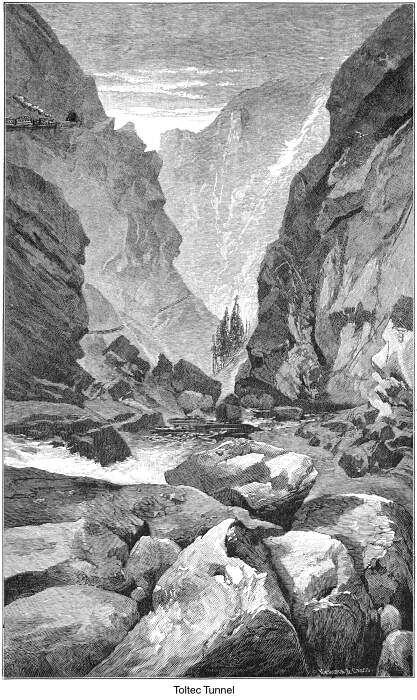
307
Double that distance downward from the railway track at Toltec
Gorge, and you have hardly begun the descent. The stone you 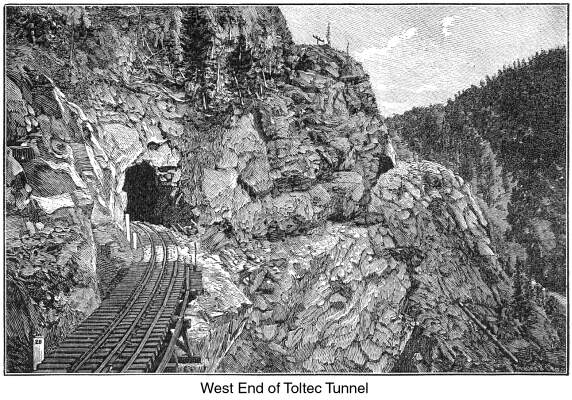 toss from your hand
drops far below, and you hear it strike again and again, hundreds
added to hundreds of feet distant, and yet silence does not signify
that it has reached the bottom; it is simply out of hearing. Double
the distance again, so far that the strongest voice can scarcely
make itself heard, and when that terrible gulf is passed you might
still look down upon the tallest steeple in America; for the railway
track at the brink of the chasm of Toltec Gorge is over eleven
hundred feet above Los Pinos Creek. But in a flash, in the twinkling
of an eye, the scene is changed. One parting glance at the far-stretching
valley and its mountain barriers, one shuddering, giddy look far
down the precipice among the jagged rocks, and then all is hid
from view in the darkness of the tunnel." toss from your hand
drops far below, and you hear it strike again and again, hundreds
added to hundreds of feet distant, and yet silence does not signify
that it has reached the bottom; it is simply out of hearing. Double
the distance again, so far that the strongest voice can scarcely
make itself heard, and when that terrible gulf is passed you might
still look down upon the tallest steeple in America; for the railway
track at the brink of the chasm of Toltec Gorge is over eleven
hundred feet above Los Pinos Creek. But in a flash, in the twinkling
of an eye, the scene is changed. One parting glance at the far-stretching
valley and its mountain barriers, one shuddering, giddy look far
down the precipice among the jagged rocks, and then all is hid
from view in the darkness of the tunnel."
The train emerges from the tunnel on the west side of the mountain,
on the very brink of a frightful precipice, fifteen hundred feet
deep, while the cliffs opposite rise over two thousand one hundred
feet.
The writer just quoted says: "At the most critical point,
where the downward view takes in the deepest depths of the gorge,
lined with crags and splintered rocks, and bowlders, as large
as, churches fallen from the cliffs above, amid which the stream
dashes downward
308
in snow-white cataracts, the train runs upon a solid bridge
of trestlework, set in the rock, as if it were a balcony from
which to obtain the finest possible view of this most wonderful
scene."
The cut shows the trestle-work quite plainly, and gives a good
idea of the descent on the west side of the mountain. It will
be noticed that the "Toltec Gorge" is entered at the
top, while the "Grand Cañon of the Arkansas"
is entered at the bottom. In the latter, the grandeur is all above
the traveller; in the former, it is all below him.
Just west of Toltec Gorge, near the track, is a monument, erected
to the memory of the martyred President Garfield, bearing the
following inscription:—
In Memoriam
JAMES ABRAM GARFIELD,
President of the United States. Died September 19,
1881.
MOURNED BY ALL THE PEOPLE.
Erected by Members of the National Association of General
Passenger and Ticket Agents,
who held Memorial Burial Services on this spot,
SEPTEMBER 26, 1881.
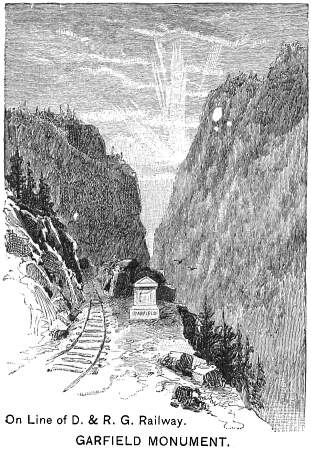
September 26 was the day on which President Garfield was buried
at Cleveland, Ohio and this excursion party stopped here for services,
and there conceived the idea of erecting a monument upon the spot.
Between Toltec Gorge and Durango the scenery is remarkably
diversified. The beautiful and sublime mingle as colors in a fine
painting. Where the railway rounds "White Rock Point,"
the view is scarcely less impressive than that at the entrance
of Toltec Gorge.
In this locality we had the first glimpse of "Dogtown,"
a city of prairie-dogs. Who has not heard of them! And yet, in
Kansas, Nebraska, and New Mexico, we caught a glimpse of only
here and there one of these historic creatures. But in southwestern
Colorado
309
we came upon the famous town,—a locality that swarmed
with these lively and somewhat eccentric inhabitants.
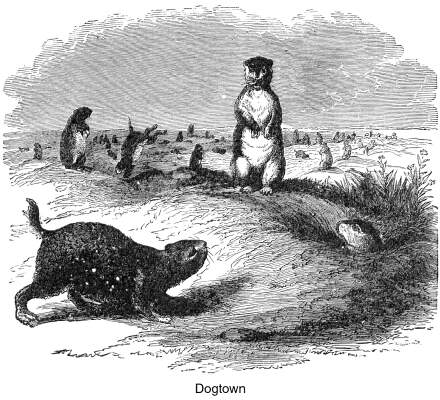 The full-grown
prairie-dog is about the size of a gray squirrel, though a multitude
of smaller ones inhabit the town, which resembles a potato-field
-the hills minus the potato-tops. He is a timid, wild little creature,
and scampers to his home on the approach of humans, with a shrill,
sharp bark, resembling that of a small dog. Dogtown is interesting
because it is novel. It speaks well for this race of diminutive
dogs that they dwell together in cities like men. Nor is it at
all discreditable to them that they run for dear life on the approach
,of a locomotive; so that, as another well says, "the town
appears alive with projecting noses and disappearing tails."
Here and there some, more experienced and bolder than the rest,—perhaps
the officials of the city,—sit upon their holes, elevated
like potato-hills, and bark defiantly. Dogtown is certainly one
of the marvels of the West. The full-grown
prairie-dog is about the size of a gray squirrel, though a multitude
of smaller ones inhabit the town, which resembles a potato-field
-the hills minus the potato-tops. He is a timid, wild little creature,
and scampers to his home on the approach of humans, with a shrill,
sharp bark, resembling that of a small dog. Dogtown is interesting
because it is novel. It speaks well for this race of diminutive
dogs that they dwell together in cities like men. Nor is it at
all discreditable to them that they run for dear life on the approach
,of a locomotive; so that, as another well says, "the town
appears alive with projecting noses and disappearing tails."
Here and there some, more experienced and bolder than the rest,—perhaps
the officials of the city,—sit upon their holes, elevated
like potato-hills, and bark defiantly. Dogtown is certainly one
of the marvels of the West.
A beaver town is, in some respects, more interesting than a
prairie-dog town. Beavers colonize and establish homes with singular
ingenuity and perseverance. Forty years ago, when trapping in
the Rocky Mountains was in its prime, the beaver population was
immense. They were able to dam large rivers, and even to turn
the
310
 course of
rivers. Groves of trees they gnaw down and cut up into logs of
suitable length for building dams. "They work like beavers"
is a phrase suggested by the industry and persistent labors of
this little animal. Trappers and tourists frequently discover
their dams now, long since built and deserted. William A. Baillie-Grohman,
the English author, who has traversed the Rockies from base to
top, describes a scene in the Wind River Mountains. "The
pools had evidently once been one single lake; but the beaver,
by ingenious dikes, had divided it into six or seven smaller sheets
of water, lying tier-like, one slightly raised over the other.
The nearest to the spring, the water was of course the highest,
about eight or ten feet being the difference between its water
level and that of the lowest miniature cascades and channel-like
timber floats, connecting the different lakelets. These channels
for timber are very ingeniously laid-out contrivances, from three
to five feet in width, and from two to four feet in depth; they
are intended for floating larger pieces of course of
rivers. Groves of trees they gnaw down and cut up into logs of
suitable length for building dams. "They work like beavers"
is a phrase suggested by the industry and persistent labors of
this little animal. Trappers and tourists frequently discover
their dams now, long since built and deserted. William A. Baillie-Grohman,
the English author, who has traversed the Rockies from base to
top, describes a scene in the Wind River Mountains. "The
pools had evidently once been one single lake; but the beaver,
by ingenious dikes, had divided it into six or seven smaller sheets
of water, lying tier-like, one slightly raised over the other.
The nearest to the spring, the water was of course the highest,
about eight or ten feet being the difference between its water
level and that of the lowest miniature cascades and channel-like
timber floats, connecting the different lakelets. These channels
for timber are very ingeniously laid-out contrivances, from three
to five feet in width, and from two to four feet in depth; they
are intended for floating larger pieces of
311
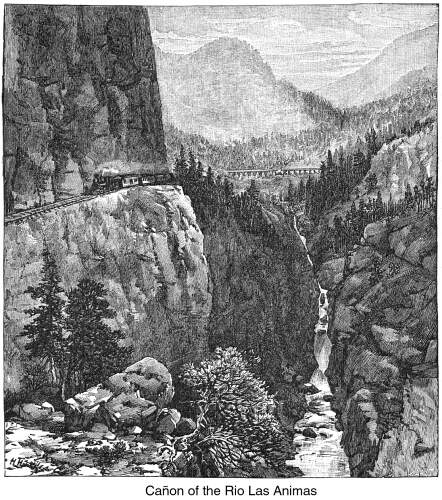 wood from
place to place, especially where the previously constructed dikes
render the transportation of trunks a difficult or impossible
job for the little workers." wood from
place to place, especially where the previously constructed dikes
render the transportation of trunks a difficult or impossible
job for the little workers."
"Beavers have left far more lasting and useful monuments
of their laborious activity on the surface of the country than
the aboriginal inhabitants. Whole valleys are fertilized by them,
the process being much quicker than one might suppose. Tersely
rendered it is as follows: Given a stream traversing a small valley
with rocky ground on which grow only occasional cottonwoods; a
colony of beaver on taking possession of it will soon make it
into meadow land. The grove of trees farthest down the stream
is first tackled. When autumn comes, few of them are left to rear
their heads. They have been gnawed down, their trunks cut into
logs, which form the foundation of an amazingly strong and massive
dam stretched across the stream where it is narrowest, forming
on the upper side a profound
312
pool as deep as the dam is high. If the supply of wood lasts,
consecutive dams will be built up stream, from thirty to a hundred
yards apart, so that finally, in the course of twenty or thirty
years, there will be no running water left. I have passed many
such streams, when for miles you will pass beaver dam upon beaver
dam." He speaks of beaver dams "forty and fifty yards
in length, seven feet high, and four feet in breadth at the base,—massive
structures wonderfully planned and built."
Animas Cañon is picturesque and remarkably diversified
with cliffs, forest, and cascades. The cut gives a view of the
cañon where the railway enters it, with a beautiful waterfall
opposite. The railway enters the cañon midway between the
valley and summit of the mountain, thereby differing from the
Arkansas and Toltec cañons, the railway entering the former
at the bottom, and the latter at the top. Some of the most difficult
railway engineering is seen in this cañon, which is entered
sixteen miles from Durango, and extends nearly thirty miles. The
track is hewn out of the rocky sides of the mountain, winding
around jagged cliffs, hundreds of feet above the valley below,
and hundreds from the summit above. Here the grandeur is both
above and beneath the traveller.
As the train was crawling very cautiously along this narrow
shelf in the mountain, where the descent was so precipitous that
passengers bad to lean forward from the windows to see the edge
of the track beneath the cars, every one maintaining a serious
silence which seemed to result from a just appreciation of "the
risky business," we said to a member of the British Parliament,
who was a passenger, "Any remarks to offer?" Without
relaxing the serious features of his face in the least, he replied,
"None whatever." This gentleman informed me afterwards,
that he had seen the greatest railroad engineering in Europe,
and travelled by rail through the wildest and grandest mountain
gorges, but nowhere had beheld more of the marvellous in art and
nature than he saw in Animas Cañon For some distance this
railway cost one hundred and sixty-five thousand dollars a mile.
The grandest view of the mountains in Animas Cañon is
where the "Needles" shoot upwards towards the sky, as
strikingly appears in the cut. It is not unlike similar scenes
in the Rocky Mountains, except that the figure is clear-cut and
peculiar.
Black Hawk and Central—two mining towns in Clear Creek
Cañon—are only one mile apart; indeed, the two towns
merge into each other. The climb of a single mile to Central is
accomplished
313
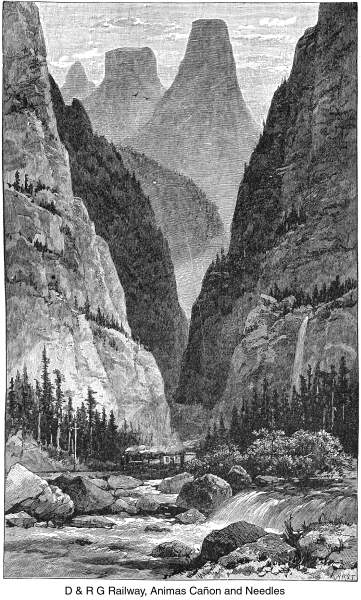 by a "switch-back,"
making four miles of track necessary. A ride over it is so novel
that it becomes sensational. "At one place, streets are crossed
above the level of the house-tops, and at another, after circling
the mountain sides for two miles, the train makes its appearance by a "switch-back,"
making four miles of track necessary. A ride over it is so novel
that it becomes sensational. "At one place, streets are crossed
above the level of the house-tops, and at another, after circling
the mountain sides for two miles, the train makes its appearance
314
hugging the mountain side hundreds of feet above, and almost
directly over the town. One can almost look down into the fiery
chimneys of the great smelters, while streets rise above, and
seemingly bottomless shafts and excavations yawn beneath in this
thrilling ride among the gold mines." A good idea of the
zigzags, curves, and remarkable ascent of the railway between
the two towns in question may be derived from the illustration.
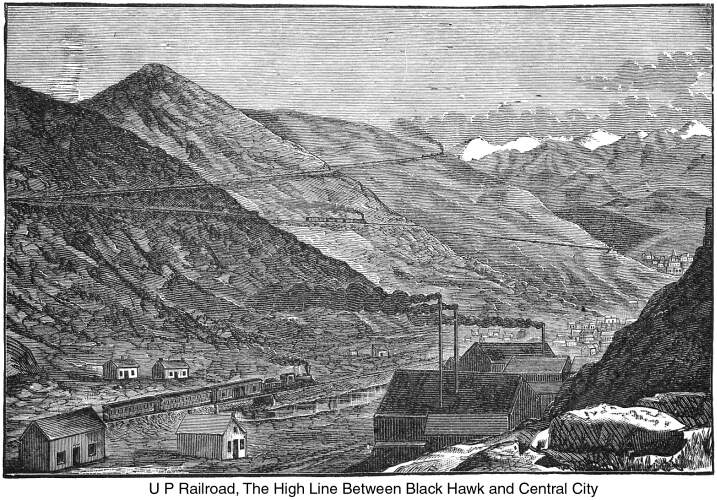
The editor of The New West wrote a very graphic description
of the Loop above Georgetown, which we copy:—
315
"Formerly those who had journeyed this far were content,
and never dreamed that anything could excel what they had seen.
If 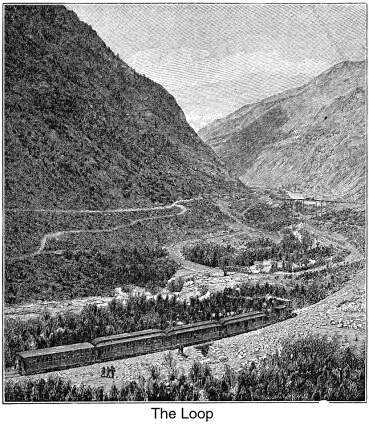 the unaided
imagination were to conjure up something more noteworthy, it would
likely be disbelieved by the sober judgment. But in reality Georgetown
is passed before an inkling of the real glories of the trip is
discovered. This part must be seen. The mind may understand readily,
a train winding through a chasm. It is less easy to understand
how it begins to rise, rise, rise along the side till finally
you look down upon a town in miniature. This is the way the train
proceeds. Through the suburbs of Georgetown, it worms its way
up a steep grade, curved and blasted through the rock. It crosses
the road leading to Green Lake, which every tourist must traverse
before leaving Colorado, and skirts the side of mountains which
lose their crests in snow. In the valley flows the little stream
of Clear Creek. Past Devil's Gate and Bridal Veil Falls, curves
and climbs the engine. Looking directly above you, you perceive
a railroad track on a high iron bridge crossing the one you are
following almost at right angles, but in the form of a crescent.
You wonder what road that is above, and how it got there. For
a little way the track is comparatively straight, then it veers
to the right, crosses the creek and starts down the valley, but
still up grade. For perhaps a quarter of a mile this continues.
Then the creek is crossed again on a high iron bridge. Looking
directly down you perceive a track below you. You wonder what
track it is, and how it got there. Look again. It is your own
track. You are on the bridge up to which you were looking a moment
ago. You have ridden over an immense loop, one of four in existence.
There is one on the Southern Pacific, one in Switzerland, and
one in the Andes of South America. But this one the unaided
imagination were to conjure up something more noteworthy, it would
likely be disbelieved by the sober judgment. But in reality Georgetown
is passed before an inkling of the real glories of the trip is
discovered. This part must be seen. The mind may understand readily,
a train winding through a chasm. It is less easy to understand
how it begins to rise, rise, rise along the side till finally
you look down upon a town in miniature. This is the way the train
proceeds. Through the suburbs of Georgetown, it worms its way
up a steep grade, curved and blasted through the rock. It crosses
the road leading to Green Lake, which every tourist must traverse
before leaving Colorado, and skirts the side of mountains which
lose their crests in snow. In the valley flows the little stream
of Clear Creek. Past Devil's Gate and Bridal Veil Falls, curves
and climbs the engine. Looking directly above you, you perceive
a railroad track on a high iron bridge crossing the one you are
following almost at right angles, but in the form of a crescent.
You wonder what road that is above, and how it got there. For
a little way the track is comparatively straight, then it veers
to the right, crosses the creek and starts down the valley, but
still up grade. For perhaps a quarter of a mile this continues.
Then the creek is crossed again on a high iron bridge. Looking
directly down you perceive a track below you. You wonder what
track it is, and how it got there. Look again. It is your own
track. You are on the bridge up to which you were looking a moment
ago. You have ridden over an immense loop, one of four in existence.
There is one on the Southern Pacific, one in Switzerland, and
one in the Andes of South America. But this one
316
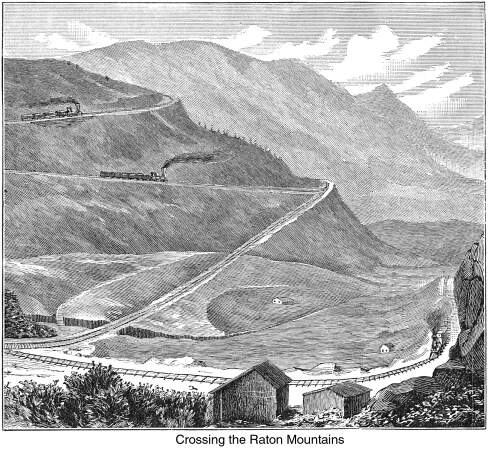 is more complex
than any of the others, the strangest feat the most skilful engineer
ever accomplished. is more complex
than any of the others, the strangest feat the most skilful engineer
ever accomplished.
"The wonderful bridge is three hundred feet long and eighty-six
feet high. From it Georgetown may be seen one way, nestled in
its mountains, and the other way there is a confusion of tracks.
It is a remarkable climb from the bridge over a fill seventy-six
feet high on too sharp a curve to admit of a bridge. There comes
near being a duplication of the loop. From here Georgetown is
still in sight beyond the three parallel tracks necessitated by
the loop. Looking down from the final curve shown in the cut,
it is easy to perceive that the display is a puzzle. There is
a wealth of track, but it dodges hither and thither, no portion
seemingly having any special relation to its neighbor. Occasionally
the entire trackage comes in range at once. Then Silver Plume
is reached, and the return trip begins.
"The distance from Georgetown to Silver Plume, in an air-line,
317
is a little over a mile; by wagon road, two miles; by rail,
four and a half miles. It is easily perceived that the extra distance
is the only method of conquering the grade. Iron is not laid for
pastime in the Rocky Mountains. The cost of this bit of eccentricity
in railroading was two hundred thousand dollars. The cost of building
clear to Bakerville, eight and a half miles, from Georgetown was
four hundred and sixty-five thousand dollars. What the ultimate
destiny of the road may be is a question. If extended to Leadville,
it would shorten the distance between that place and Denver to
one hundred and twelve miles. By the South Park, now far the shortest
line, it is one hundred and fifty. But whatever it may be, and
may do, it has certainly given to the tourist opportunity never
before offered to inspect the wonders of nature and mechanical
science."
We described the "switch-back," by which the cars
are able to ascend from Black Hawk to Central. On a grander scale,
the same device carried the train, on the Atchison, Topeka &
Santa Fe Railroad, over the Raton Mountains—a spur of the
Rocky Mountains—into New Mexico.
It is fifteen miles from Trinidad to the summit of the pass,
and an average rise of one hundred and twenty-one feet to the
mile is required. If this rise were equally distributed, it would
not be excessive; but it is not. In some places the railway must
ascend nearly two hundred feet to the mile; and, on the home-stretch,
the rise is over three hundred feet to the mile, and at first
was accomplished by a switch-back. "By it the cars left what
is now the direct line, and were carried over a steep incline
track, running diagonally up the hill; thence, reversing their
direction, they shot up another incline; then reversing again,
they climbed to the summit, thus zigzagging up the steep they
could not directly scale. Even by this indirect route, the enormous
grade of 316.8 feet per mile was attained." On the New Mexico
side, the railway descended, in like manner, to a point where
a tunnel, two thousand and eleven feet long, has been excavated,
thus superseding the use of the switch-back, and shortening the
line by several miles. The cut opposite furnishes a correct view
of the railroad over the mountain.
There is another very remarkable loop in the Tehachapi Pass,
California. The next illustration shows the course of the railway
to the summit of the pass, together with the loop. Within twenty-five
miles, the train rises nearly three thousand feet,—the altitude
at the pass being three thousand nine hundred and sixty-four feet,—passing
through SEVENTEEN tunnels, the aggregate length of which is 7,683.9
feet. The tourist is well paid by this wonder for his longest
trip.
318
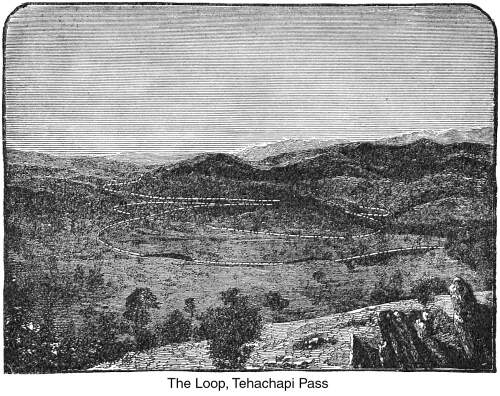 The loop is
three thousand seven hundred and ninety-five feet in length, the
upper track being severity-eight feet higher than the lower track.
The engineering skill displayed in the construction of this road
will amply reward the tourist for his journey across the continent
to see it. The scenery along the route is indescribably grand.
Sometimes the train poises upon a dizzy height, from which the
traveller looks down into frightful chasms that make him shudder.
The loop is three hundred and forty miles from San Francisco. The loop is
three thousand seven hundred and ninety-five feet in length, the
upper track being severity-eight feet higher than the lower track.
The engineering skill displayed in the construction of this road
will amply reward the tourist for his journey across the continent
to see it. The scenery along the route is indescribably grand.
Sometimes the train poises upon a dizzy height, from which the
traveller looks down into frightful chasms that make him shudder.
The loop is three hundred and forty miles from San Francisco.
After passing through the ninth tunnel, the track makes a graceful
curve around the loop, and crosses it, at a distance above, as
represented by the following cut. Let the reader take in, if possible,
the engineering feat which the illustration correctly represents.
There is the ninth tunnel, and the railroad train crossing both
tunnel and loop far above it. Surely, here is a marvel of American
enterprise!
In descending the Sierra Nevada Mountains, from Summit to Colfax,
the Union Pacific train winds around many precipitous cliffs,
affording the traveller a favorable opportunity to look down into
many
319
frightful chasms. The most remarkable of these cliffs is represented
by the cut (p. 320) called "Cape Horn." There is the
train rounding it, at a height well calculated to excite alarm,—the
last place a railway train would have been placed, even in the
dreams of an enthusiast, twenty years ago. Some travellers claim
that the grandest and most exciting railway ride in the whole
world is this from Summit to Colfax. No language can describe
the scenery. Timid souls shrink and tremble, possibly, whirling
around perilous curves, and rushing forward on the edge of awful
precipices. But the experience pays.
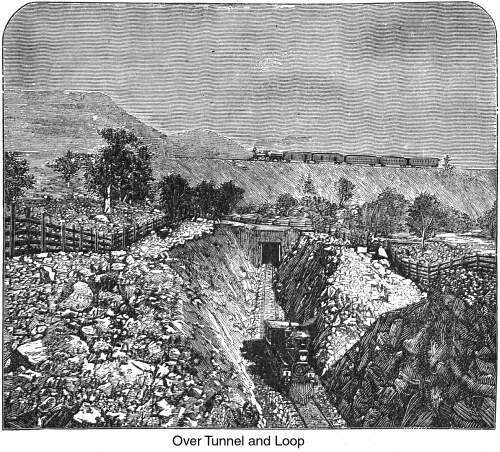
The memory of the ride will be reckoned as an income during
the remainder of life.
Marvellous railway engineering, on the Sierra Nevada range,
is seen in the American River Cañon, as represented by
the cut on p. 321.
The grade of this road for seven miles is six hundred feet
to the mile—too steep, of course, to be operated by steam;
so it was built to be operated by mules. Some of its curves are
thirty degrees. The whole of its work is the triumph of enterprise
over stupendous obstacles.
320
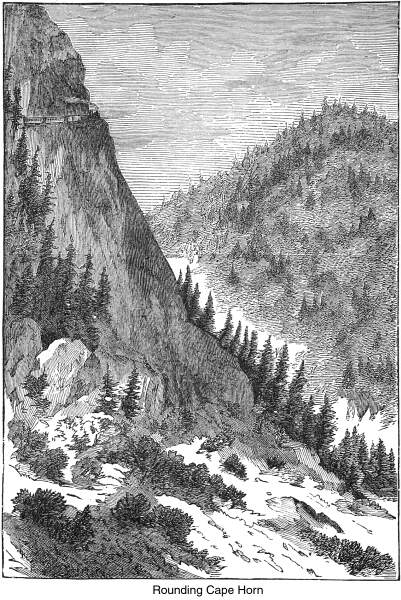 The Calumet
Branch Railway of the Leadville division of the Rio Grande is
a marvellous affair, and the reader will be interested in the
following description of it, by one who is perfectly familiar
with minutest details. He says:— The Calumet
Branch Railway of the Leadville division of the Rio Grande is
a marvellous affair, and the reader will be interested in the
following description of it, by one who is perfectly familiar
with minutest details. He says:—
"Nobody has ever well described the wonderful little feeder
of the Leadville division which modestly leaves the main line
in Brown's Cañon and ascends the mountain gulches to the
east with the steepest
321
grades and the heaviest curves in the world that are overcome
with the ordinary drive-wheel locomotive. Afar up in this range
of mountains, seven miles away, and nearly three thousand feet
higher than the bed of the cañon, is the famous Calumet
mine, from which is extracted the hematite iron ore that keeps
in blast the furnaces of the Bessemer works at Pueblo. Every morning
of the year a ponderous locomotive and a small train of cars toils
up this steep, and every afternoon they make the perilous descent
to the valley, loaded with iron, with the steam brakes on the
cars, the water pressure on the locomotive drivers, and a man
standing at the brake-wheel of each car.

This is the most wonderful piece of railroading in the universe.
The maximum grade is four hundred and six feet to a mile, or nearly
eight per cent, and the maximum curvature, twenty-five degrees.
The terminal of the branch is half a mile higher than the commencement.
Imagine, then, the difficulty in ascending with empty cars, and
the danger of descending with loaded ones. Still, strange though
322
it may seem, a locomotive cannot make the descent unless at
least five cars are attached. The latter are essential to provide
the resisting power for the steam brakes. The trip up is snalish;
the return is rapid in spite of the steam pressure which cuts
the car-wheels into sparks that fly out in a constant stream from
the brakes, in spite of the reverse action, in spite of the lavish
use of the sand-pipes, and in spite of the water brake on the
locomotive drive-wheels.
"Some few years ago, when the operation of the line was
commenced, runaway accidents were of almost daily occurrence.
The seven miles were within a brief period strewn with the wrecks
of cars and locomotives and iron ore. The most discouraging results
attended the persistent efforts to make the line serve the purpose
for which it was constructed. Day after day control over the descending
train would be lost; some defect would interfere with the working
of the steam brake; and even with the brake in successful operation,
the train would take a crazy notion and go flying down the mountain
sides, along the brinks of fearful precipices, through the rock-bound
gullies, and around the acute curves like a bolt of lightning.
The train hands would leap for life, and the locomotive and cars
would be dashed into fragments. In all these accidents, however,
nobody was hurt. Thousands and thousands of dollars' worth of
rolling stock is said to have been destroyed before a successful
system of operation was established. Only very few of the higher
officials of the Rio Grande realize how terrible was the experience
of these rides, and it is told of two of them who once summed
up sufficient curiosity and courage to make the journey that they
were so frightened that they hung on to the steps of the caboose,
expecting every moment to have to leap for life.
"Finally, extremely heavy locomotives were built, and
a force of exceptionally brave trainmen were secured. The latter
were instructed to cling to their post at every hazard, and to
never flinch in the moment of danger. Not a serious accident has
been recorded since. Starting from the mine, every brake is manned,
so that in case the steam should fail, the train could be checked.
While there have been several runaways, in two years there has
not been a wreck. The sight of one of these trains descending
is one of thrilling- interest, the sparks from the car-wheels
cutting a pathway of light down the mountains, which can best
be described as having the appearance of a molten stream of fire
rolling down to the river-bed of the cañon.
"In Switzerland there are grades as steep as these of
the Calumet
323
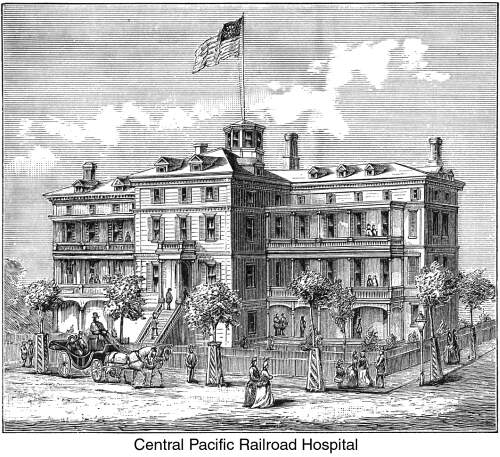 Branch, but
they are equipped for operation with the cable and cogwheels." Branch, but
they are equipped for operation with the cable and cogwheels."
The leading railway companies in the New West support hospitals
for their employees. The cut below represents the Central Pacific
Railroad Hospital at Sacramento. It is a fine stone building,
occupying an open square, and was erected at an expense of sixty
thousand dollars. Here the sick or injured employee finds a pleasant
home, with the best of care, until he is restored, and is able
to return to work. The physician who has this hospital in charge
stands at the head of his profession in Sacramento, and he is
provided with the best of nurses, and other facilities to make
a first-class hospital. A monthly assessment of fifty cents each,
from officers and men, beginning with the president of the company,
pays the current expenses of the institution. This wise provision
for the sick and suffering is very popular with the men and their
families. To them it is a pledge of help in the time of need.
It is common, also, for the railroad companies of the New West
to provide reading-rooms for their employees. We have been furnished
with the following account of what the Atchison, Topeka &
Sante Fe Railroad has done in this line:—
"The Atchison, Topeka & Sante Fe Railroad Company
has
324
established a rather extensive system of reading-rooms for
the benefit of their employees throughout Kansas and New Mexico.
The rooms are comfortably furnished, heated, lighted, and kept
neat and clean by the company. The company provides all the better
periodicals of the day, games, and mechanical reference books.
It, however, depends upon voluntary contributions of the citizens
where these rooms are located to supply a library. There are fifteen
of them located at the various division points. At Argentine,
New Mexico, quite a number of handsome volumes have been generously
donated by private citizens. At Emporia, Kan., the citizens have
come forward promptly, and a New York gentleman has donated one
hundred volumes to that reading-room. Topeka also has one. At
Nickerson, Kan,, the people have responded very generously, as
also at Dodge City and Raton, Kan., while at Las Vegas a very
fine collection of books has been presented by the citizens. At
San Marcial a collection of about two hundred volumes of the best
standard literature has been presented by the Hon. E. W. Kinsley,
of Boston."
Railroading in the New West makes mammoth bridges a necessity.
The bridge over the Missouri River, at Omaha, is a great work,
both in conception and execution. It is one mile in length including
its approaches. It is "Post's Pattern." "The hollow
iron columns are twenty-two in number, two forming a pier. These
columns are made of cast iron, one and three-fourths of an inch
in thickness, eight and a half feet in diameter, ten feet long,
and weigh eight tons each. They are bolted together air-tight,
and sunk to the bed-rock of the river, in one case, eighty-two
feet below low water. After these columns are seated on the rock
foundation, they are filled up twenty feet with stone concrete,
and from the concrete to the bridge seat they are filled with
regular masonry. From high-water mark to the bridge seat these
columns measure fifty feet. The eleven spans are two hundred and
fifty feet in length, making the iron part between abutments,
two thousand seven hundred and fifty feet. These columns were
cast in Chicago, and delivered in the shape of enormous rings,
ten feet in length. When they were being placed in position, the
workmen would take two or more rings, join them together, place
the column where it was to be sunk, cover the top with an air-lock,
then force the water from the column by pneumatic pressure, ranging
from ten to thirty-five pounds per square inch. The workmen descend
the columns by means of rope ladders, and fill. sand-buckets,
which are hoisted through the air-lock by a pony-engine. The sand
is then excavated about two feet below the bottom
325
of the column, the men come out through the air-lock, a leverage,
from one hundred to three hundred tons, is applied, the pneumatic
pressure is removed, and the column sinks, from three inches to
two and one-half feet—in one instance, the column steadily
sank down seventeen feet. Whenever the column sinks, the sand
fills in from ten to thirty feet—in one instance, forty feet.
This has to be excavated before another sinking of a few inches
can take place, making altogether a slow and tedious process."
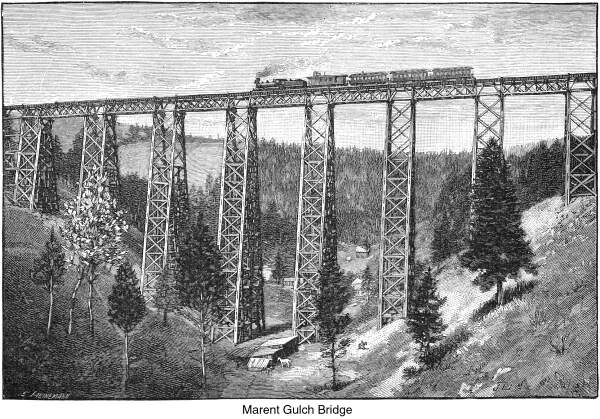
326
Congress authorized the building of this bridge, July 25, 1866,
but little was done upon it until March, 1868. Then work commenced
in earnest, but was discontinued for some reason, after sixteen
months. Again, in April, 1870, the American Bridge Company of
Chicago took up the work; but it was not carried to final consummation
until Congress authorized the Union Pacific Railroad, Feb. 24,
1871, to complete it, and issue bonds to the amount of $2,500,000.
The Marent Gulch is in the Cariacan Defile, on the Northern
Pacific Railway, not far from the Flathead Reservation. The stream
flowing through it is small, but the gulch is deep and dismal.
The bridge over it, represented by the cut on page 325, is one
of the highest in the United States. It is two hundred and twenty-six
feet high and eight hundred and sixty long. It is a Howe truss
resting on eight towers.
Near by this structure is another large bridge—the O'Keefe
bridge—one hundred and twelve feet high and one thousand
feet long.
The Northern Pacific Railway passes through Clark's Fork, where
not even a wagon-road existed before, nothing but a perilous bridle-path
travelled by Indians, gold-seekers, and fur-traders. Pack-animals
could not travel over twelve or fifteen miles a day on this trail.
Clark's Fork is spanned by three mammoth bridges. The first
is a five-span Howe truss, eight hundred feet long, with trestle
approach of six hundred feet—fourteen hundred feet in all.
Fifty miles further up is another Howe truss bridge, of three
spans, four hundred and eighty feet long, and ninety feet above
the water. The third bridge is situated seven miles above the
junction of the Flathead and Missoula, and is ten hundred and
fifty feet long, including approaches.
Smalley, in his "History of the Northern Pacific Railroad,"
says: "In the rock-work Mr. Hallett employed a method new
in railroad construction, which he had first successfully used
on the Columbia River line. The old way of cutting a roadbed along
the face of a cliff was to begin at the top, drill small holes
and blow off the rock, little by little, down to grade. Mr. Hallett
began at the bottom, a little below grade, made a number of T-shaped
tunnels, filled them with great quantities of powder, and touched
them all off at the same moment by electricity. The effect was
stupendous, the whole side of the mountain wall being lifted up
and hurled into the river. Great saving in time and money was
thus effected. A similar method was applied to through cuts, by
means of perpendicular shafts and lateral galleries. One cut twenty-four
feet deep by four hundred feet long
327
was excavated by a single blast of giant powder, most of the
rock being thrown entirely out, and the rest so broken up that
it was readily removed by derricks."
The same authority tells us that the most stupendous land-slide
known in railroad building occurred in this vicinity in April,
1883.
Forty acres, covered with trees, slid off into the river, carrying
the track with it, and partially obstructing the river."
The magnitude of business and enterprise in the New West also
creates the necessity for the largest ferry-boat in the whole
world. It is found on the Straits of Carquincy, in California,
and is run by the railway company to shorten the distance to Sacramento.
The Straits are one mile and a half wide.
Crofutt describes this monster ferry-boat as follows: "The
'Solano' is the same length as the 'City of Tokio,' and has the
greatest length of beam of any vessel afloat. Her dimensions are:
length over all, 424 feet; length of bottom,—she has no keel,—406
feet; height of sides in centre, 18 feet 5 inches; height of sides
at each end from bottom of boat, 15 feet 10 inches; moulded beam,
64 feet; extreme width over guards, 116 feet; width of guards
at centre of boat, 25 feet 6 inches; reverse shear of deck, 2
feet 6 inches. She has two vertical steam engines of 60-inch bore
and 11-inch stroke. The engines have a nominal horse-power each,
but are capable of being worked up to 2,000 horse-power each,
The wheels are 30 feet in diameter, and the face of the baskets,
17 feet. There are 24 baskets in each wheel, 30 inches deep. She
has eight steel boilers, each being of the following dimensions:
length over all, 28 feet; diameter of shell, 7 feet; 143 tubes,
16 feet long by 4 inches diameter each; heating surface, 1,227
feet grate surface, 224 feet; entire heating surface, 9,816 feet;
entire grate surface, 1,792 feet. The boilers are made in pairs,
with one steam smoke-stack to each pair, 5 feet and 6 inches in
diameter. She has 4 iron fresh-water tanks, each 20 feet long
and 6 feet in diameter; registers 483,541.31 tons. She is a double
ender, and at each end has four balance rudders, each 11 feet
6 inches long and 5 feet 6 inches in depth. They are constructed
with coupling-rods, and each has one king-pin in the centre for
the purpose of holding it in place. The rudders are worked by
an hydraulic steering-gear, operated by an independent steam pump,
and responds almost instantaneously to the touch. The engines
are placed fore and aft, and operate entirely independent, each
operating one wheel. This arrangement of the engines and paddles
makes the boat more easily handled entering or leaving the slips,
or turning quickly when required, as one wheel
328

can be made to go ahead and the other to reverse at the same
time. One wheel is placed eight feet forward, and the other eight
feet abaft
329
the centre of the boat. It has four tracks running from end
to end, with the capacity of 48 freight, or 24 passenger cars.
In its construction, 1,500,000 feet of lumber were used. Many
of the timbers are over 100 feet long; four, the keelsons, are
117 feet long, each measuring 4,032 feet."
Mountain Railroading
| Contents Page
|







